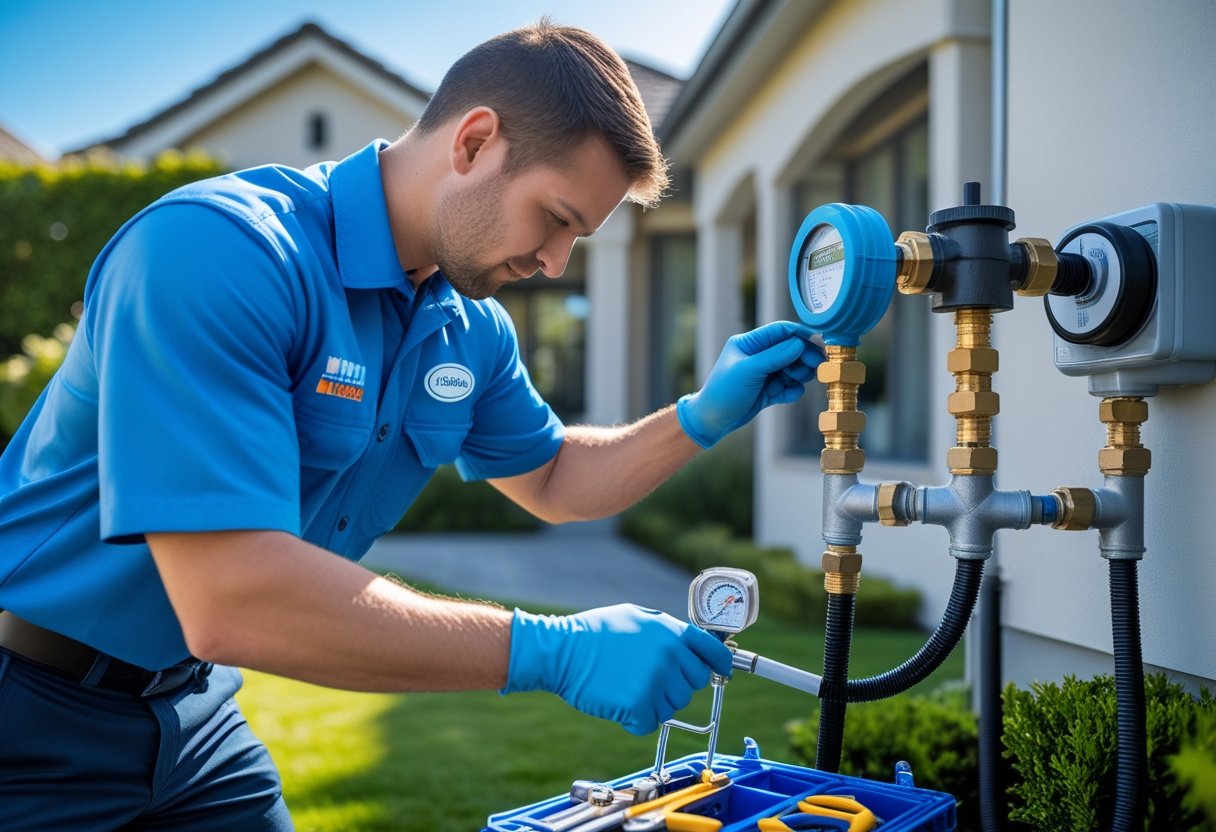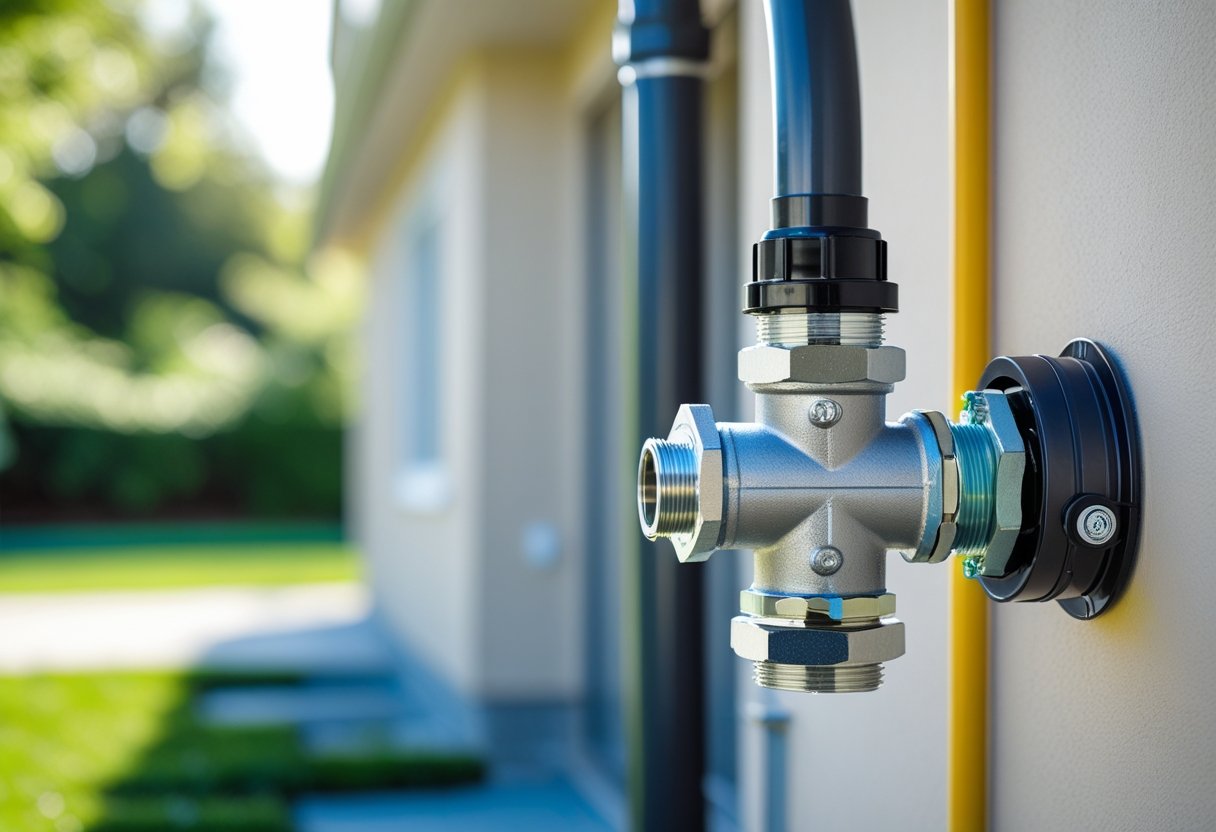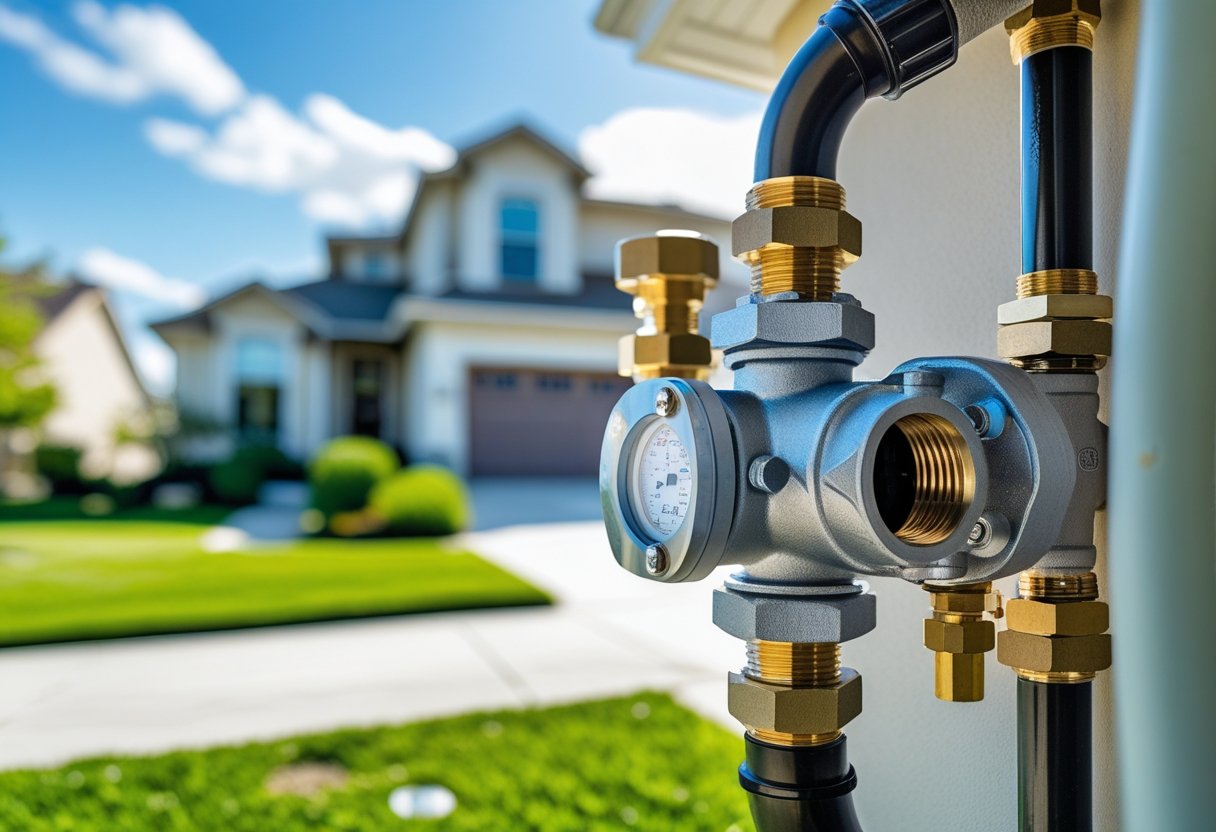Understanding the different types of backflow preventers is essential for choosing the right one for your specific needs, whether for your irrigation system, fire protection, or main water line.
Protecting your home's drinking water is something many homeowners overlook until there's a problem. Backflow preventers play a crucial role in keeping your potable water supply safe from contaminants that could flow backward into your system.
We often see confusion about which backflow prevention device is appropriate for different situations. The four main types vary in complexity, cost, and application. Some are simple enough for DIY installation, while others require professional help and may even be legally mandated by local regulations.
In this guide, we'll break down each type of backflow preventer, explain how they protect your water supply from contamination, and help you determine which is best suited for your home.
Through the topics below, you’ll learn which devices meet local code, protect your water supply, and avoid costly inspection failures:
- Why backflow preventers aren't all the same
- Understanding the 4 Main types of backflow preventers
- Which backflow preventer do you need?
- Get help choosing and installing the right device with Pacific Backflow
Keep reading! By the end, you'll have the knowledge needed to make an informed decision about keeping your family's water safe.
Why backflow preventers aren't all the same
Backflow preventers come in several distinct types, each designed for specific applications and hazard levels. The right choice depends on your plumbing system, local regulations, and the potential contamination risk.
According to the EPA, backflow prevention assemblies must be tested regularly, and the frequency should match the level of contamination hazard. High-risk systems may require more frequent inspections to avoid compliance issues.
Different devices serve different water systems
Backflow preventers are classified based on the level of protection they provide against contamination. The four main types include Reduced Pressure Zone (RPZ), Double Check Valve Assembly (DCVA), Pressure Vacuum Breaker (PVB), and Atmospheric Vacuum Breaker (AVB).
RPZ devices offer the highest protection level, making them ideal for high-hazard applications like chemical processing plants or medical facilities. They contain two independently acting check valves with a relief valve between them.
DCVAs work well for moderate hazard situations and consist of two spring-loaded check valves in series. They're commonly used in irrigation systems and fire sprinkler systems.
PVBs are simpler and protect against back-siphonage but not back-pressure. They're often installed on irrigation systems and outside hose connections.
AVBs provide basic protection against back-siphonage only and are the simplest and least expensive option.
City codes in california may require specific types
California has some of the strictest building codes for backflow prevention in the country. These regulations vary by water district and city.
The California Plumbing Code (CPC) specifies which type of backflow preventer must be used based on the degree of hazard. High-hazard connections generally require RPZ devices, while lower-hazard applications may permit DCVAs.
Many California water districts require annual testing by certified testers. This testing must be documented and submitted to the water authority.
Important California Requirements:
- Annual testing by certified professionals
- Installation by licensed plumbers
- Permits required before installation
- Inspection by local water authority
- Specific clearance and installation height requirements
Choosing the wrong device can lead to inspection failure
Selecting an inappropriate backflow preventer can result in failed inspections and costly replacements. We've seen many homeowners face this frustrating situation.
The most common inspection failures include:
- Installing a lower protection device than required by code
- Improper installation height or clearance
- Missing test ports or shut-off valves
- Using non-approved devices
- Lack of proper drainage for RPZ relief valves
Building inspectors check for compliance with both local and state codes. They verify that the device matches the application's hazard level and is installed correctly.
Water district requirements often include specific brands or models on their approved lists. Always check with your local water authority before purchasing any backflow prevention device.
Understanding the 4 Main types of backflow preventers
Backflow preventers are essential devices that protect your potable water supply from contamination. Each type offers different levels of protection and is designed for specific applications based on the degree of hazard present.
Pressure Vacuum Breaker (PVB): Common for irrigation systems
Pressure Vacuum Breakers are frequently used in residential irrigation systems. They prevent water from flowing backward into your clean water supply when pressure drops.
PVBs must be installed at least 12 inches above the highest sprinkler head or outlet in your system. This height requirement is crucial for proper functioning.
These devices work well in most outdoor applications but have limitations. They cannot be used if there's back pressure in the system, only back siphonage.
PVBs are relatively affordable compared to other backflow preventers. They're also easier to maintain with fewer moving parts than more complex systems.
Most local codes permit PVBs for residential irrigation, but always check your specific requirements. They offer good protection for low to medium hazard situations.
Atmospheric Vacuum Breaker (AVB): Low-Cost, limited use
Atmospheric Vacuum Breakers are the simplest and most affordable backflow preventers available. They consist of a body, air inlet valve, and check valve.
AVBs must be installed at least 6 inches above all downstream piping and outlets. They cannot be used under continuous pressure for more than 12 hours at a time.
Key limitations:
- Cannot have valves downstream
- Must be installed vertically
- Cannot be tested once installed
These devices are ideal for simple applications like hose bibs or service sinks. They provide basic protection against back-siphonage but not back pressure.
AVBs are often used where the risk of contamination is minimal. They're a good option for homeowners on a budget with simple backflow prevention needs.
Double Check Valve Assembly (DCVA): Often used in fire sprinkler systems
Double Check Valve Assemblies consist of two spring-loaded check valves that work together to prevent backflow. They're commonly used in fire sprinkler systems and irrigation setups.
DCVAs can be installed below ground in some jurisdictions, making them versatile for different property layouts. They're designed for low to medium hazard applications.
These assemblies can handle continuous pressure and back pressure situations. This makes them more flexible than AVBs and PVBs.
Annual testing is required to ensure proper functioning. Most municipalities have strict requirements about DCVA maintenance and certification.
DCVAs provide good protection against non-health hazards like dirt or non-toxic substances. For higher risk situations involving chemicals or health hazards, a different solution is needed.
Reduced Pressure Zone (RPZ) Device: Highest protection, required in high-risk setups
RPZ devices provide the highest level of protection against backflow. They're required in high-hazard situations where contamination could cause serious health risks.
These devices contain two check valves with a pressure-differential relief valve in between. This design creates a "zone" of reduced pressure that ensures water only flows in one direction.
RPZs must be installed above ground and protected from freezing. They need clearance for maintenance and to allow the relief valve to discharge when necessary.
Common applications include:
- Chemical processing facilities
- Medical buildings
- Irrigation systems with chemical injection
- Commercial buildings with high contamination risks
RPZs are the most expensive option but provide peace of mind when serious cross-contamination is possible. They require annual testing by certified testers.
The relief valve may discharge water occasionally during normal operation. This is actually a sign the device is working properly to prevent contamination of your potable water supply.
Which backflow preventer do you need?
Choosing the right backflow preventer depends on your specific situation, local regulations, and the level of hazard present in your water system. Different properties have different needs based on their usage and potential contamination risks.
After installation, every type of backflow preventer, whether RPZ, DCVA, PVB, or AVB, must be tested annually by a certified technician. This requirement is supported by both utility guidelines and DOE standards to ensure long-term device reliability.
Residential vs commercial systems
For most homes with simple irrigation systems, a Pressure Vacuum Breaker (PVB) or an atmospheric vacuum breaker will suffice. These are cost-effective options that work well for low-hazard residential applications. PVBs must be installed at least 12 inches above the highest sprinkler head.
Commercial properties typically require more robust protection. Reduced Pressure Zone (RPZ) devices are common in commercial settings where higher hazards exist. These provide maximum protection but cost more to install and maintain.
Businesses that handle chemicals or hazardous materials are almost always required to use RPZ devices, regardless of size. This includes properties like car washes, manufacturing facilities, and medical offices.
The system complexity also matters - larger systems with multiple zones may need different types of preventers for different areas.
What your city or water district requires
Local regulations vary significantly regarding backflow prevention. Many municipalities have specific requirements based on your property type and water usage.
Some districts require annual testing by certified professionals, while others may allow homeowner testing. Check with your local water authority before installation to avoid costly mistakes.
Most water districts classify hazards into three levels:
- Low hazard: Minimal risk of contamination
- Medium hazard: Some risk exists
- High hazard: Significant contamination risk
Your classification determines which devices are acceptable. Some cities maintain an approved devices list that you must select from.
Remember that compliance isn't optional - water districts can shut off service to properties that don't meet requirements. We recommend getting written approval before installation.
When an upgrade is mandatory (after a failed test or system change)
Failed backflow tests usually require immediate action. Most water districts give property owners 30 days to fix or replace a failing device before penalties apply.
Common reasons for test failures include:
- Damaged internal seals
- Freeze damage
- Improper installation
- Age-related wear
System modifications almost always trigger a reassessment. Adding a pool, expanding irrigation, or changing water usage patterns may require upgrading your backflow prevention.
Older devices may need replacement even if they still function. Many areas now require newer models with better protection features. Devices over 10 years old should be evaluated for potential replacement.
When upgrading, consider future needs to avoid another replacement soon. Installing a slightly higher-grade device than minimally required can save money long-term.
Get help choosing and installing the right device with Pacific Backflow
Selecting and installing the right backflow preventer requires professional expertise to ensure water safety and code compliance. Pacific Backflow offers comprehensive services to guide you through the entire process from assessment to installation.
Expert assessment based on local code
Our team at Pacific Backflow stays current with all local building codes and regulations regarding backflow prevention. We conduct thorough on-site evaluations to determine which of the four main types of preventers is appropriate for your property.
The assessment includes analyzing your water system, identifying potential hazards, and measuring water pressure throughout your plumbing system. We consider factors such as:
- Size of your landscape irrigation system
- Location of installation (indoor vs. outdoor)
- Local climate conditions
- Water usage patterns
- Specific county requirements in San Diego and surrounding areas
This detailed approach ensures we recommend the most suitable device that provides maximum protection while meeting all compliance standards.
Replacement and retrofitting services
Many homes have outdated or inadequate backflow prevention systems that need upgrading. Our retrofitting services make transitioning to a proper system smooth and efficient.
We handle the complete replacement process, from removing old devices to installing new ones with minimal disruption to your water service. Our technicians are skilled at working with existing plumbing configurations to integrate modern preventers.
Common retrofitting scenarios we address include:
- Upgrading from simple check valves to double-check assemblies
- Replacing underground installations with more accessible above-ground options
- Converting non-compliant systems to meet current regulations
We also help homeowners understand the benefits of newer models, which often provide better protection and easier maintenance access than older systems.
Full compliance and certified backflow installation
All our installations meet or exceed industry standards and local requirements. Our certified installers have extensive training and experience working with all types of backflow preventers.
The installation process includes:
- Proper positioning of the device
- Secure mounting and support structures
- Correct connection to your existing plumbing
- Thorough testing after installation
- Complete documentation for compliance records
We provide detailed documentation of the installation and initial test results for your records and local water authority submissions. Our work comes with a satisfaction guarantee, and we offer follow-up maintenance services to ensure continued proper operation.
Regular testing is essential for continued compliance. We can schedule annual inspections to maintain your system's certification and protect your water supply.
Conclusion
Choosing the right backflow preventer is essential for protecting your safe drinking water from contamination. We've explored the four main types—PVBs, DCVAs, RPZs, and AVBs—each serving specific needs based on your plumbing setup and local requirements.
Remember that backflow prevention is not just about compliance with regulations—it's about homeowner responsibility and safeguarding your family's health. The right device can prevent harmful substances from entering your drinking water supply.
Installation complexity varies by type, with some suitable for DIY projects while others require professional installation. Many municipalities require annual testing and maintenance to ensure these devices function properly.
Before making your final decision, we recommend consulting with a licensed plumber who understands local codes. They can help determine which type best suits your specific needs and ensure proper installation.
By taking the time to understand these devices and maintaining them properly, you're making an important investment in your home's plumbing infrastructure and your family's wellbeing. Clean, safe water is something we should never take for granted.
Schedule a certified backflow preventer assessment today to ensure your system meets code and provides the right level of protection for your home.












